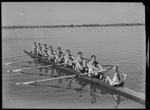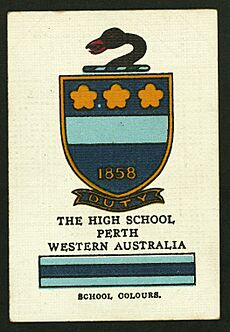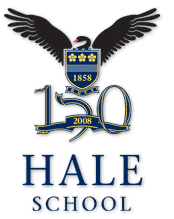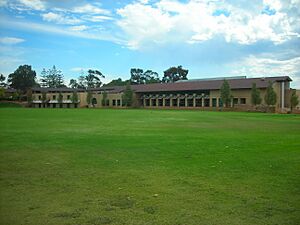Hale School facts for kids
Quick facts for kids Hale School |
|
|---|---|
 |
|
| Location | |
|
,
Australia
|
|
| Coordinates | 31°54′41″S 115°46′51″E / 31.91139°S 115.78083°E |
| Information | |
| Type | Independent, day & boarding |
| Motto | Duty |
| Denomination | Anglican |
| Established | 1858 |
| Sister school | St Mary's |
| Chairman | Mark Foster |
| Head of Senior School | David Bourne |
| Deputy Head of Senior School | Simon Hunt |
| Head of Year 7 | Jackie Hunt |
| Head of Junior School | Tim Simpson |
| Headmaster | Dean Dell'Oro |
| Chaplain | Thomas Couper |
| Employees | 257 |
| Median ATAR | 91.85 (2021) |
| Gender | Boys |
| Enrolment | ~1,500 (1–12) |
| Colour(s) | Oxford blue & Cambridge blue |
| Affiliation | Public Schools Association |
Hale School is an independent school for boys in Wembley Downs, a suburb of Perth, Western Australia. It is an Anglican school, meaning it has ties to the Anglican church. Students can attend as day students or live at the school as boarders.
The school was founded in 1858 by Bishop Mathew Blagden Hale. It is considered one of the oldest private boys' schools in Western Australia. Over the years, Hale School has moved several times. It started at the Cloisters in Perth, then moved to the Pensioner Guard Barracks around 1880, and later to Havelock Street in 1914. In 1961, the school moved to its current large campus in Wembley Downs.
Today, the campus has a junior school for students from Pre-Primary to Year 6, a middle school for Year 7, and a senior school for Years 8 to 12. It also has many sports fields and places for students to live if they are boarders.
Hale School is part of the Public Schools Association and the Junior School Heads Association of Australia. Its sister school is St Mary's Anglican Girls' School, which is located nearby. In 2008, Hale School celebrated its 150th birthday!
Contents
School History
Hale School has a long history, dating back to Australia's early colonial days. It was one of the first high schools in Western Australia. Many important people from the early Swan River Colony studied there. The school was first called Boys High School.
In the past, schools like Hale were sometimes seen as only for certain groups of people. However, Hale School has worked to become more open to everyone. For example, it now offers scholarships, including the first full boarding scholarships in Western Australia for Indigenous students. This helps students from different backgrounds attend the school.
The school's name and history have changed over time. Bishop Hale started a private school in 1858. Later, in 1863, the Church of England set up the "Church of England Collegiate School." Bishop Hale's school eventually joined this new school, and it became known as "Hale's School."
In 1878, a new state-funded "High School" opened. This new school attracted many students, and "Hale's School" eventually closed in 1885. However, in 1958, 100 years later, the "High School" was renamed "Hale School" to honor its connection to Bishop Hale's original vision.
School Leaders
Here is a list of the Headmasters who have led Hale School over the years:
| Period | Details |
|---|---|
| 1858–1863 | Canon George Hallett Sweeting |
| 1864 | Acting Headmaster – John Bussell |
| 1864–1869 | Rev. FT Taylor |
| 1869–1872 | Rev. FA Hare |
| 1872–1878 | Col. EW Haynes |
| 1878–1882 | Rev. D Davies |
| 1882–1888 | T Beuttler |
| 1888–1889 | N Millington |
| 1889–1914 | FC Faulkner |
| 1915–1928 | MA Wilson |
| 1929–1931 | PR Le Couteur |
| 1931–1946 | MA Buntine |
| 1940–1943 | C Hadley (Acting) |
| 1946–1960 | VS Murphy |
| 1960–1965 | JR Prince |
| 1966 | L Drake (Acting) |
| 1967–1988 | KG Tregonning |
| 1989–2002 | John Inverarity |
| 2003–2016 | Stuart G Meade |
| 2017 | David Bean (Acting) |
| 2017– | Dean Dell'Oro |
School Campus
Hale School is built on a large, 48-hectare campus in Wembley Downs. The main administration building, Memorial Hall, and the Tom Hoar Dining Hall are all near the main entrance. You can also find the Stowe Drama Centre, Forrest Library, and the Chapel of St Mark in this area.
The Peter Wright Technology Building has workshops for design and technology, plus computer labs. It's next to the Doug Poake Pool. Near the pool, there's also an art complex, a gym, and changing rooms.
The John Inverarity Music and Drama Centre is on the western side of the campus. This building helps separate the Senior School from the Junior School. The Junior School is in the northwest part of the campus, along with Brine House, which is a boarding house for younger students. The main boarding house for older students is on the eastern side. The rest of the campus is filled with sports fields.
Forrest Library
A new learning area, including the Forrest Library, opened in 2009. This library has a special study area for Year 12 students and rooms for gifted students. Below the library, you'll find a clothing store, the IT department, and a meeting room.
The library was officially opened by Andrew Forrest and named in honor of the Forrest family. Many members of this family, including Sir John Forrest and Alexander Forrest, went to Hale School.
This area also has a new cafeteria with indoor and outdoor seating. There's also a new teaching building with 17 classrooms for subjects like History, English, and languages.
In 2010, the Australian Institute of Architects gave the Forrest Library an award for its design.
John Inverarity Music and Drama Centre
The John Inverarity Music and Drama Centre opened in 2001. It has a large auditorium for performances, backstage rooms, and two main rehearsal studios. There are also studios for percussion and string instruments, two big music teaching rooms, and 19 smaller practice rooms.
The main part of the center is the auditorium, which can seat 353 people. It's designed to have great natural sound for music. The room can be adjusted for different instruments and performances using special wall panels and ceiling reflectors. This makes sure the sound is always just right.
Middle School
A new Middle School building was built between 2009 and 2010. It is located next to Unwin Avenue. This building has 16 classrooms for Year 7 and 8 students. Year 8 classrooms are on the ground floor, and Year 7 classrooms are on the first floor.
The main entrance and offices for the Middle School leaders are on a separate level, at street height with Unwin Avenue. The building also includes refurbished classrooms for music, drama, and science.
Junior School
The Hale Junior School was built when the Wembley Downs campus first opened. Today, it teaches students from Pre-Primary to Year 6, with about 400 students. The original building was replaced in 2017 with a new, award-winning campus.
The new Junior School has a modern design. Students are grouped into 'Lower Junior' (Pre-Primary to Year 2), 'Middle Junior' (Year 3 and Year 4), and 'Upper Junior' (Year 5 and Year 6). All the buildings have open areas called 'breakout spaces.' These spaces are great for small group work or presentations.
Sporting Facilities
Hale School has many excellent sports facilities on its campus, including:
- an eight-lane, 25-meter heated swimming pool
- a ten-lane, 50-meter heated swimming pool
- a gymnasium with courts for basketball, badminton, volleyball, squash, and a rock climbing wall
- a weights room
- a rowing machine room
- 16 tennis courts (12 hard courts, 4 grass courts)
- 4 football fields
- 4 outdoor basketball courts
- 5 cricket ovals with grass pitches
- 32 cricket practice wickets (both artificial and grass)
- 4 soccer fields
- cross country running tracks
- 2 rugby fields
- track and field facilities
- a hockey field with a special surface and clubrooms
- 3 additional grass hockey ovals
- a rowing boat shed at Cygnet Hall on the Swan River (off campus)
In 1885, the school had a team in the first season of the West Australian Football Association. However, they had to stop playing after two games because they didn't have enough players.
Hale School has also hosted important sports teams. For example, the English Rugby Team trained there during the 2003 Rugby World Cup. The English Cricket Academy, with famous players like Michael Vaughan and Stuart Broad, also used the school's facilities for practice.
House System
Hale Middle and Senior School has 10 different 'houses.' These houses are like teams that students belong to. There are 8 day houses (for students who go home each day) and 2 boarding houses (for students who live at the school).
- Buntine – red (named after a former headmaster)
- Faulkner (boarding) – light green (named after a former headmaster)
- Havelock – black and yellow striped
- Haynes – yellow (named after a former teacher)
- Loton – orange and navy blue
- Parry – navy blue (named after the Parry family, who gave a large donation)
- Riley – dark green
- Meade (formerly St Georges) – red and white (named after a former headmaster)
- Tregonning – maroon (named after a former headmaster)
- Wilson (boarding) – blue (named after a former headmaster)
Loton used to be a boarding house but became a day house in 2005. Year 7 and 8 boarders live in Brine House, but they are also part of either Faulkner or Wilson houses.
The Hale Junior School also has 4 houses, named after famous scholars:
- Davy – Dark green
- Turnbull – Blue
- Rosier – Yellow
- Walker – Red
Academic Achievements
Hale School is known for its strong academic results. Since 2000, students from Hale School have won five Beazley Medals. This medal is given to the student who gets the highest marks in the state's final exams for university entrance.
The school often appears in the top 10 schools for the Western Australian Certificate of Education rankings.
| Year | % +75 in WACE | State ranking | % +65 in WACE | Median ATAR | State ranking | % graduation |
|---|---|---|---|---|---|---|
| 2021 | 91.85 | 100 | ||||
| 2020 | 90.35 | 100 | ||||
| 2019 | 92.85 | |||||
| 2018 | 89.4 | |||||
| 2017 | 89.3 | |||||
| 2016 | 89.8 | |||||
| 2015 | (prior to ATAR reporting) | |||||
| 2014 | 27.09 | 7 | 59.89 | (prior to ATAR reporting) | 5 | 100 |
| 2013 | 28.17 | 5 | 58.59 | (prior to ATAR reporting) | 5 | 100 |
| 2012 | 28.77 | 4 | 66.95 | (prior to ATAR reporting) | 3 | 100 |
| 2011 | 36.69 | 1 | 72.14 | (prior to ATAR reporting) | 2 | 100 |
| 2010 | 25.73 | 10 | 65.47 | (prior to ATAR reporting) | 8 | 99.50 |
| 2009 | 6 | (prior to ATAR reporting) | 2 | 99.49 |
Sports Achievements
Hale School is a member of the Public Schools Association (PSA). This means they compete against other schools in various sports.
PSA Premierships
Hale School has won many PSA premierships (championships) in different sports:
- Athletics (14 wins) – 1920, 1921, 1922, 1923, 1924, 1925, 1928, 1934, 1939, 1941, 1992, 2001, 2002, 2017
- Badminton (4 wins) – 2005, 2007, 2008, 2019
- Basketball (12 wins) – 1984, 1985, 1986, 1987, 1988, 1989, 1994, 1995, 2008, 2017, 2022, 2024
- Cricket (28 wins) – 1905, 1906, 1907, 1909, 1911, 1916, 1922, 1925, 1933, 1934, 1938, 1947, 1948, 1950, 1956, 1961, 1966, 1967, 1976, 1992, 1995, 1999, 2000, 2001, 2002, 2009, 2011, 2019
- Football (22 wins) – 1921, 1939, 1941, 1947, 1966, 1973, 1978, 1984, 1985, 1989, 1995, 1996, 1999, 2001, 2003, 2009, 2010, 2012, 2014, 2016, 2017, 2019
- Golf (6 wins) – 2004, 2006, 2007, 2010, 2013, 2015
- Hockey (5 wins) – 1980, 1990, 2012, 2014, 2019
- Rowing (2 wins) – 2000, 2001
- Rugby (24 wins) – 1964, 1965, 1969, 1971, 1974, 1975, 1977, 1980, 1982, 1999, 2001, 2003, 2004, 2005, 2006, 2007, 2008, 2009, 2010, 2011, 2012, 2013, 2014, 2015
- Soccer (10 wins) – 1993, 1997, 1998, 1999, 2004, 2005, 2006, 2010, 2018, 2019
- Surfing (3 wins) – 2006, 2016, 2017
- Swimming (40 wins) – 1919, 1923, 1925, 1926, 1931, 1932, 1933, 1934, 1935, 1936, 1937, 1944, 1965, 1967, 1968, 1969, 1970, 1971, 1972, 1973, 1974, 1975, 1976, 1977, 1978, 1979, 1980, 1981, 1982, 1983, 1984, 1986, 1991, 1992, 1998, 2003, 2013, 2014, 2015, 2016
- Tennis (18 wins) – 1965, 1966, 1968, 1971, 1972, 1973, 1976, 1977, 1985, 1986, 1997, 1998, 1999, 2003, 2004, 2005, 2006, 2014
- Volleyball (3 wins) – 2019, 2021, 2022
- Water Polo (4 wins) – 1997, 2008, 2014, 2015
Hale School and the Australian Defence Force
Many former students of Hale School have served in different conflicts, starting from the Boer War. Some have had very successful military careers.
Corporal Ben Roberts-Smith, who graduated from Hale in 1995, is a highly recognized soldier. He has received the Victoria Cross and the Medal for Gallantry for his bravery.
One hundred and twenty-four former Hale students have passed away in conflicts since the Boer War. There is a special Memorial Grove at the school to honor these men. It has 124 plaques and a sculpture with an "eternal flame" design. The school's main hall is also called Memorial Hall. The Hale School Museum keeps important records about the school and Western Australia's history, including military records.
Images for kids
Famous Former Students
An alumnus (or former student) of Hale School is called an Old Haleian. Here are some notable Old Haleians:
- Hugo Armstrong – a skilled pilot in World War II
- Christian de Vietri – artist
- Matthew Ebden – professional tennis player
- Andrew Forrest – a successful businessman
- Sir John Forrest – the first leader of Western Australia
- Michael Gardiner – AFL football player
- Lang Hancock – businessman
- Robert Juniper – painter
- Robert Drewe – author
- Matthew Lutton – theatre and opera director
- Geoff Marsh – cricket player and coach
- Sir Stephen Parker – a top judge in Western Australia
- Todd Pearson – Olympic swimming medalist
- Benjamin Roberts-Smith VC – a soldier who received the highest military award, the Victoria Cross
- Sam Roberts-Smith – opera singer
- Paul Royle – World War II pilot and a participant in the famous Great Escape from Stalag Luft III
- Sharafuddin Idris Shah – the Sultan of Selangor, Malaysia
- Rolly Tasker – sailor
- Tunku Ismail Idris – Crown Prince of Johor
- Melvin Poh – entrepreneur
- Peter Wright – mining businessman
- Dane Haylett-Petty – rugby union player
- Ross Haylett-Petty – rugby union player
- Justin Turner – rugby union player
- Ryan Hodson – rugby union player
- Luke Burton – rugby union player
- Nick Jooste – rugby union player
- Edward Russell – television presenter
- Marcus Stoinis – cricketer
- Christian Porter – state and federal politician
- Daryl Mitchell – Cricketer (New Zealand Blackcap)
- David Irvine – former head of Australian intelligence agencies
- Tom Mitchell – plays AFL football for Hawthorn, won the Brownlow Medal in 2018
- Shane McAdam – AFL Footballer
- Kyron Hayden – AFL Footballer
- Mitch Georgiades – AFL Footballer
- Jy Farrar – AFL Footballer
- Darcy Cameron – AFL Footballer
- Meyne Wyatt – Actor, Writer
- Basil Zempilas – Lord Mayor of Perth
See also
- List of schools in the Perth metropolitan area
- List of boarding schools in Australia
- List of Anglican schools in Australia














